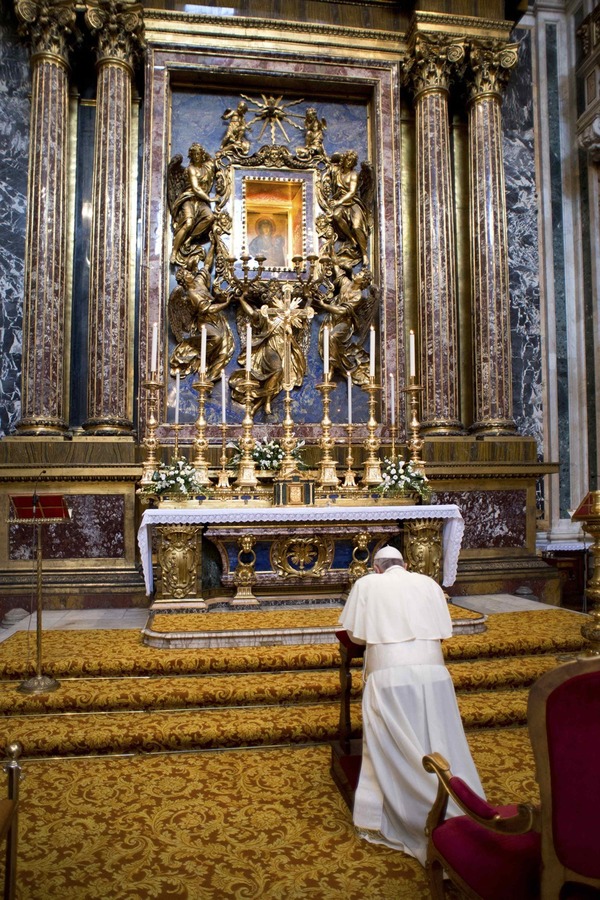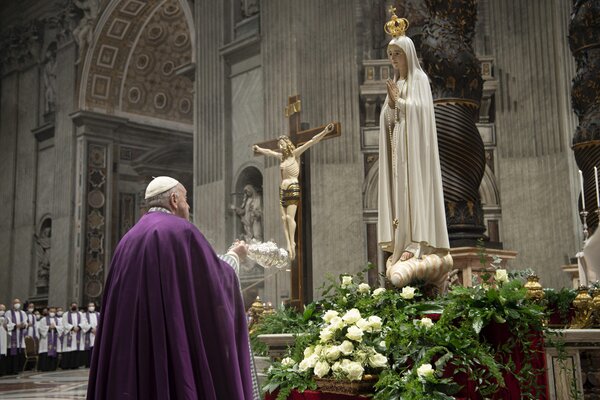By Melissa Corsi and Paula Katinas
PROSPECT HEIGHTS — The decision by Pope Francis to break with tradition and be buried at the Papal Basilica of St. Mary Major in Rome rather than the Vatican is shining a spotlight on the 5th-century basilica dedicated to the Blessed Virgin Mary.
Pope Francis is the first pontiff to be buried at St. Mary Major (in Italian, Santa Maria Maggiore) in nearly 400 years.
The last was Pope Clement IX, who died in 1669.
Pope Francis’ devotion to the Blessed Virgin Mary was well known. In 2018, he declared a new feast day dedicated to her, the Feast of Mary, Mother of the Church, to fall on the Monday after Pentecost.
Throughout his 12-year papacy, he had a special connection to the basilica. Before and after each apostolic trip to a foreign nation, the Holy Father would go there to pray.
He maintained that connection even in his final weeks. When he was released from the hospital on March 23 after a 38-day stay, he had the car pull up outside the basilica so he could pray before returning to the Vatican.
Msgr. Steven Aguggia, chancellor for the Diocese of Brooklyn, was in Rome for the canonization of Carlo Acutis, which has since been postponed, on the day Pope Francis passed away.
He explained that not only is the choice of the basilica itself significant, but the spot within the building where the late pontiff will be buried is also notable.
The Holy Father requested that his tomb be placed next to the Pauline Chapel, which houses the Salus Populi Romani (Latin for Salvation of the Roman People), a famous Marian icon. Consisting of a painted image of the Madonna and Child, Salus Populi Romani is attributed to St. Luke the Evangelist, the patron saint of painters, and has been displayed in the basilica since 590.
“I think the icon probably went into the pope’s decision as well,” Msgr. Aguggia said, adding that the basilica, which he has visited many times, is the type of place that can take one’s breath away.
“It’s magnificent when you walk in,” he said. “It overwhelms you with the size of it, but also the beauty of it and the history of it.”

Pope Francis prays in front of the icon of “Salus Populi Romani,” (health of the Roman people), at St. Mary Major Basilica in Rome July 20, 2013. (Photo: CNS/L’Osservatore Romano)
Father Joseph Gibino, vicar for the secretariat for evangelization and catechesis for the diocese, who has stepped inside the basilica many times, called it magnificent.
“As you enter into the basilica, it kind of forces you to look up and take in the whole incredible image of the church, but also the glory of God,” Father Gibino said. “It’s one of those places where it is very easy to sense God’s grandeur and the importance of Mary as Mother of the Church.”
The Basilica of St. Mary Major is one of four papal basilicas in Rome — the others are St. Peter, St. John Lateran, and St. Paul Outside the Walls.
With a tower standing 240 feet and a main nave measuring 280 feet, it is the largest Marian church in the Eternal City.
The history of the basilica dates back to Aug. 5, 352, when Pope Liberius had a vision of the Virgin Mary, who instructed him to build a church in a spot where snow would fall that night, despite the fact that it was summer. It is believed that snow did indeed fall.
That miracle is the reason the Blessed Virgin Mary is sometimes referred to as “Our Lady of the Snows.” To commemorate that miracle, white flower petals are released from the ceiling in the Pauline Chapel to simulate snow every Aug. 5.
The Church of St. Mary Major was built in 354, but in 432, Pope Sixtus III had it demolished and replaced by a larger structure in response to the Second Council of Ephesus in 431 — the gathering at which bishops affirmed the doctrine that Mary is truly the mother of God.
While the basilica has undergone a number of revisions over the centuries, “it’s now got a very Baroque style to the architecture and the artwork inside,” Msgr. Aguggia said. “But it does retain the ancient shape of the basilica as it was built centuries ago.”
The interior “is overwhelmingly beautiful, with the Baroque type of art, which is very elaborate,” he added.
In addition to the Salus Populi Romani, the basilica houses an important relic — wood from the manger in which Jesus was placed after his birth. For this reason, the basilica is often referred to as “Bethlehem of the West.”
Given Pope Francis’ devotion to the Blessed Virgin Mary, Father Gibino said he wasn’t surprised to learn that the basilica will be the Holy Father’s final resting place.
“It made sense that he would choose it as a place to be buried,” Father Gibino said, “near the heart of the church.”

Pope Francis burns incense in front of a Marian statue after consecrating the world and, in particular, Ukraine and Russia to the Immaculate Heart of Mary during a Lenten penance service in St. Peter’s Basilica at the Vatican March 25, 2022. (Photo: CNS/Vatican Media)